Cavendish Banana
Musa acuminata
Family: Musaceae | Place of Origin: New Guinea
Origins and history:
The first known domestication of bananas was in Kuk Valley of New Guinea. They are native to Southeast Asia and the South Pacific but were traded globally with high demand. Hybridization of species sparked commercial production yielding more resilient crops to meet supply. Bananas are a religious connection for some cultures. Inca tribes for example would adorn tombs with banana leaves as sacred parts of their lives. There are also Buddhist practices that use green bananas surrounding a green coconut as a traditional offering. India reveres bananas as the “remedy of all ills.

Identification characteristics
- Roots: They grow in hot humid tropical regions from clustered root systems called rhizomes that grow in shoots. These shoots can start a new growth cycle as the roots spread outward and buds begin vertical growth.
- Leaf morphology: As they develop a stem, leaves will form in layers. The leaf of a banana plant is simple and elongated. Their waxy and glossy structure have an assortment of health benefits.
- Fruit and Floral morphology: A banana flower is beautiful and complex. Many small female flowers grow together in what is called an inflorescence. Once matured the florets will swell up and the ovaries will develop into bananas.
- Scent: Bananas start out as small green fruit bodies. As bananas grow their smells will change from grassy, sweet, to musty depending on ripeness.
Uses and preparation
Bananas are made fresh, fried, steamed, boiled, dried, roasted, or turned into beverages. There are packed with vitamins, nutrients, fiber, and sugar. Some healing qualities of banana plants include improved cholesterol and blood pressure. Fiber can be used for dietary and material purposes. Serotonin in the roots and magnesium in the flowers have anti-depressant properties.